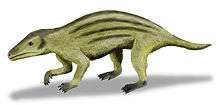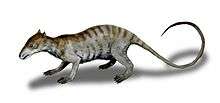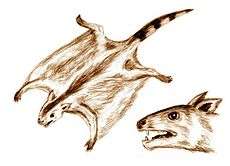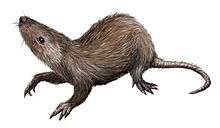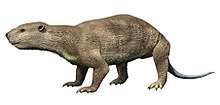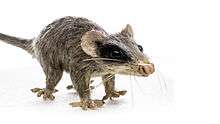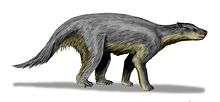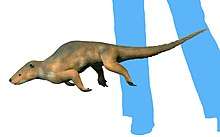Vincelestes
Vincelestes ("Vince's thief") is an extinct genus of actively mobile mammal, that lived in what would be South America during the Early Cretaceous from 130—112 mya, existing for approximately 18 million years.[1]
| Vincelestes | |
|---|---|
| Artist's restoration | |
| Scientific classification | |
| Kingdom: | |
| Phylum: | |
| Class: | |
| (unranked): | |
| Family: | Vincelestidae |
| Genus: | Vincelestes |
| Species: | V. neuquenianus |
| Binomial name | |
| Vincelestes neuquenianus | |
Description
Vincelestes neuquenianus is the only species known to date. Specimens were found in La Amarga Formation of southern Neuquén Province, Argentina. The remains of only nine individuals were recovered from this site.
The back teeth of Vincelestes were similar to those of therians in that they were capable of cutting and grinding. This enabled them to process food more efficiently.
Phylogeny
Although not the direct ancestor of therians, Vincelestes is important because it gives us an idea of what the ancestor of both placental and marsupial mammals might have looked like, and also gives an indication of when these mammals may have originated.
Some studies inversely recovered the genus as an australosphenida,[2][3] although current thought places Vincelestes as sister to marsupials and placental mammals.[4][5]
References
- PaleoBiology Database: Vincelestes, basic info
- Chimento, Nicolas; Agnolin, Federico; Martinelli, Agustin (May 2016). "Mesozoic Mammals from South America: Implications for understanding early mammalian faunas from Gondwana". Historia Evolutiva y Paleobiogeográfica de los Vertebrados de América del Sur. pp. 199–209.
- Bonaparte, José F. (17 September 2008). "On the phylogenetic relationships of". Historical Biology. 20 (2): 81–86. doi:10.1080/08912960802164470.
- Huttenlocker, Adam K.; Grossnickle, David M.; Kirkland, James I.; Schultz, Julia A.; Luo, Zhe-Xi (23 May 2018). "Late-surviving stem mammal links the lowermost Cretaceous of North America and Gondwana". Nature. 558 (7708): 108–112. Bibcode:2018Natur.558..108H. doi:10.1038/s41586-018-0126-y. PMID 29795343.
- Bi, Shundong; Zheng, Xiaoting; Wang, Xiaoli; Cignetti, Natalie E.; Yang, Shiling; Wible, John R. (13 June 2018). "An Early Cretaceous eutherian and the placental–marsupial dichotomy". Nature. 558 (7710): 390–395. Bibcode:2018Natur.558..390B. doi:10.1038/s41586-018-0210-3. PMID 29899454.
Further reading
- Turner, A. (2004). National Geographic Prehistoric Mammals. Firecrest Books. p. 46.
- Kielan-Jaworowska, Z.; Cifelli, R.; Luo, Z. (2004). Mammals from the Age of Dinosaurs: Origins, Evolution, and Structure. Columbia University Press. p. 399.

